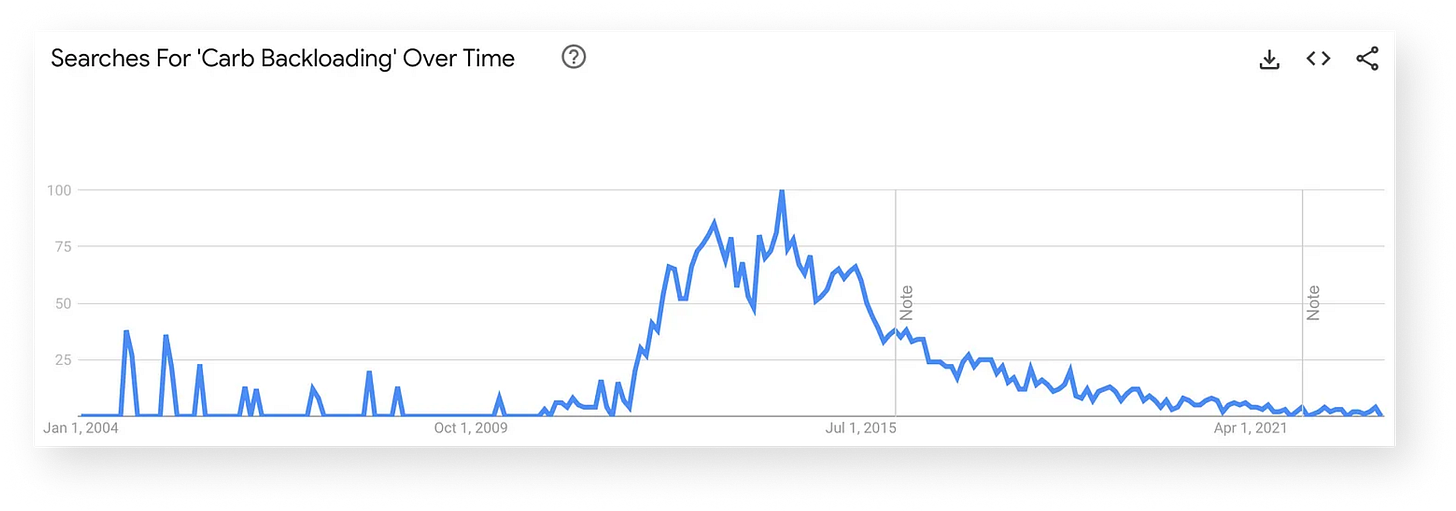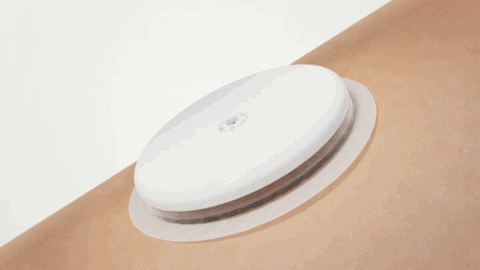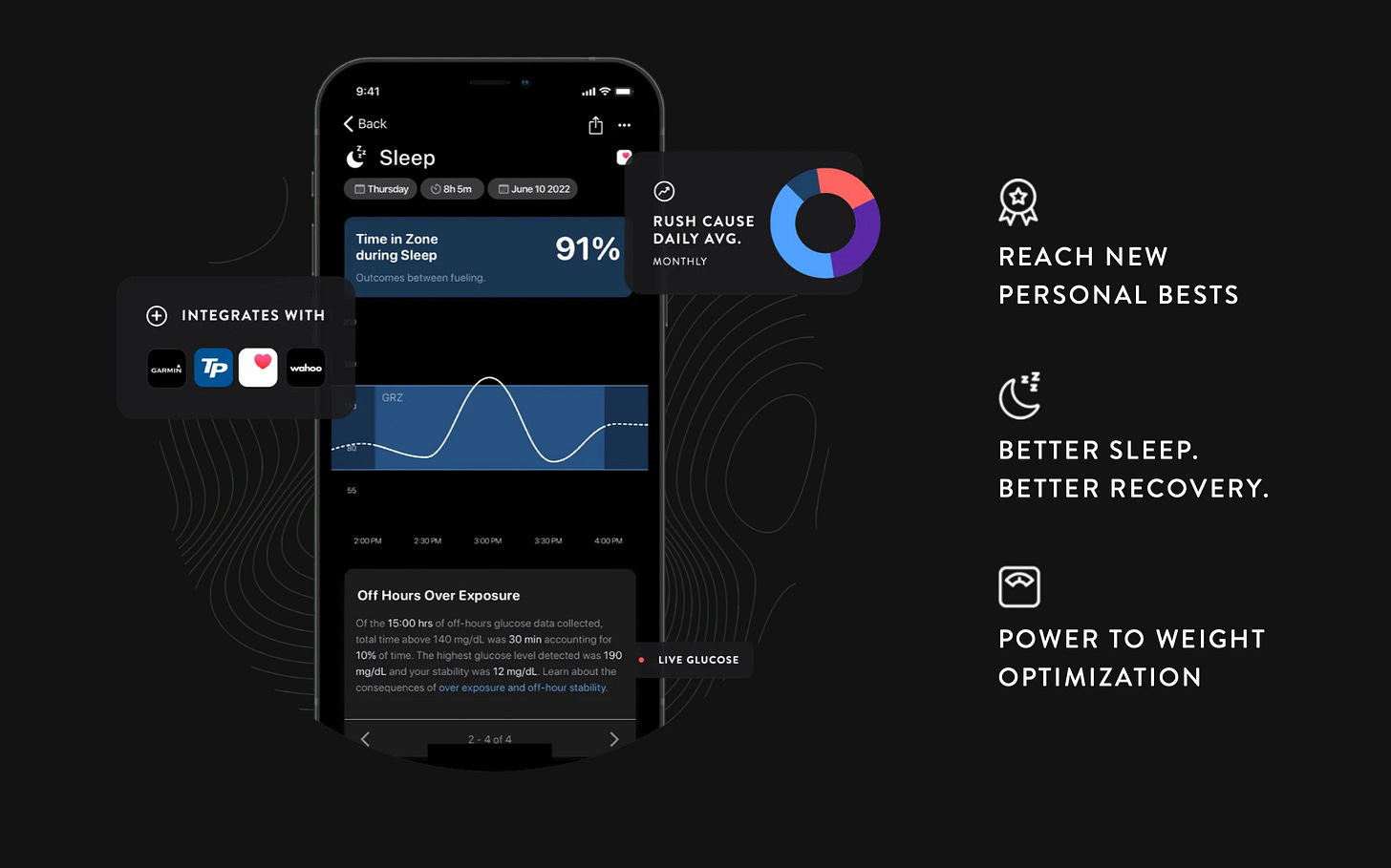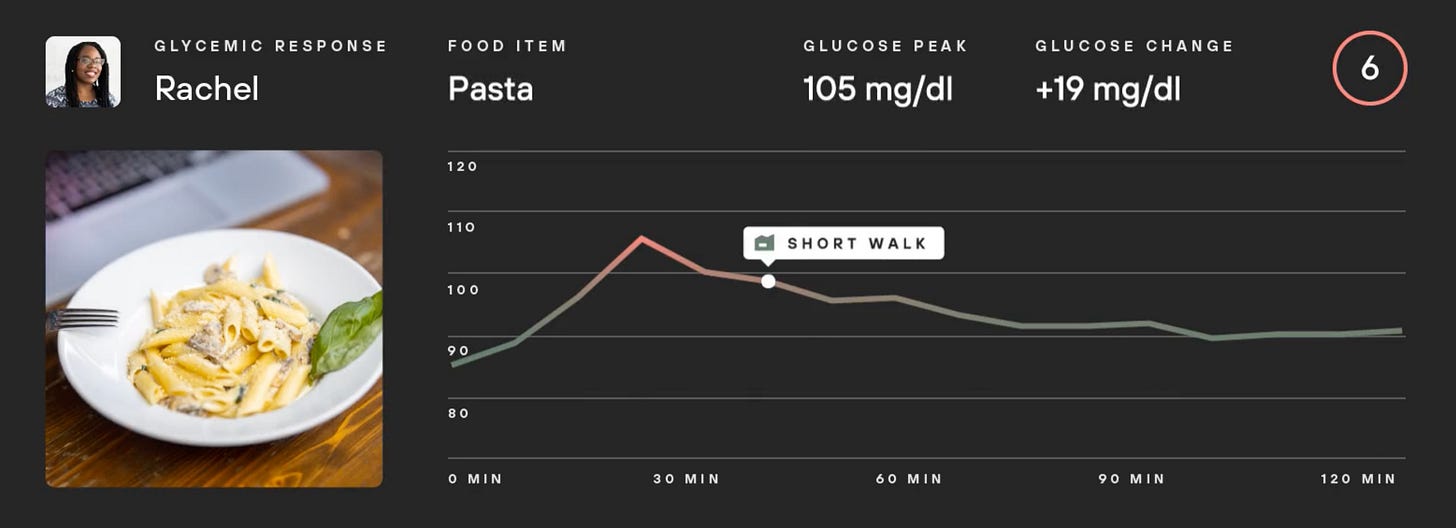#02: Continuous Glucose Monitoring - a new performance tool?
A new generation of wearables, originally built to help diabetes sufferers, is gaining traction as a metric for performance, wellness and longevity
Before we start, a quick reminder.
I’m Andrew, I was an Olympic athlete, then I moved into building health tech businesses - I’ve built and exited two businesses over the last 10 years. We bootstrapped our first business in 2013 through to acquisition 5 years later, then I helped lead the EMEA part of a global health and diagnostics business through to IPO on the Nasdaq in 2022.
I write deep dives into exciting businesses and technologies at the intersection of sport, health, nutrition and mindset - I call this Human Performance Tech.
Ok, let’s go…
Glucose & Human Performance
I have a long and complex relationship with glucose spikes. As an athlete, I'd oscillate wildly between being extremely conscious of controlling my blood sugar, (at times having almost zero carbohydrate/being completely ketogenic) and then at other times wielding a blatant disregard for insulin resistance by binge eating four packets of Jaffa Cakes in a single sitting.
Sometimes I'd marry the two with “carb back-loading” (Remember that? Nor does the internet.)

Whatever my cavalier approach to metabolic health whilst I was a full-time exerciser, it felt like a secret life hack that I even knew the role that glucose management played in body composition, energy levels, sleep and performance.
At the time, the most common nutritional advice for health was to eat low-fat (maybe it still is?) and the closest we’d come to really take action on glucose spikes was considering the Glycemic Index (GI) of foods.
Today, it’s now possible to buy a CGM (Continuous Glucose Monitor), and while it’s clear the largest utility for these is for diabetes sufferers, I’m interested in digging into if, and how, there’s any true utility in constantly measuring blood glucose for performance, everyday health and longevity. (Spoiler: Surprisingly, I think there is)
What the blood sugar is going on?
Now we’ve entered a kind of third age of glucose understanding in relation to our everyday health and performance. This is being supercharged by the accessibility of quasi-realtime glucose monitoring, delivered primarily by two devices - the Abbott Freestyle Libre, and Dexcom.
They’re normally worn on your upper arm, and when applied a tiny filament is inserted just beneath the skin. It’s surprisingly not that painful to attach and relatively comfortable to wear 24 hours a day.
Although you’ll see marketing claims about real time, most of the devices will transmit a reading of your interstitial glucose levels every minute or so to another device (i.e. your smartphone)
Of course, these devices are manufactured with a clear medical purpose and a clear cohort of patients to serve - people with diabetes whose lives depend on accurately controlling their glucose spikes.
But here we are, writing a newsletter about human performance technology - and CGM’s are in the hot seat.
Businesses being businesses, and humans being humans, now there’s a growing cohort of startups (who are almost certainly not targeting diabetic patients) bringing CGM monitoring solutions to market. Some research groups are starting to look at these applications outside of diabetes patients too.
Building the human performance layer for CGM
As with most medical devices, the actual manufacturers don’t tend to be the ones who give the best experience to the end user - CGM is no different. What we’re seeing is a number of businesses, mainly using the Abbot device, bringing offerings to market with their own user experience layer on too - and Venture money has been flowing generously into the space.
Levels Health from the USA has raised $57m from Tier 1 VC’s, on a mission to “improve metabolic health using biowearables” and feels very much to align to my concept of a Human Performance brand.
Veri, based in Finland but shipping to most of Europe, UK and the US, has raised €10.8 from Accel and Profounders
SuperSapiens, who have raised ~$13m, are focusing the use of CGM heavily on sports and human performance as their value prop
Zoe, based in London, although not strictly a CGM company as such, provides a CGM as a core part of their personalised nutrition service. Backed with almost $80m in VC capital, (and cofounded by your mum’s favourite professor) they’re taking a wider holistic approach to nutrition rather than focusing purely on glucose management.
Other brands in the space, in no particular order, with or without a human performance angle:
NutriSense, ClearBio, HelloInside, January.Ai, Ultrahuman, Signos
Are we witnessing a new paradigm in wearables?
I’m not sure, but I hope so.
But, there’s a trillion-dollar gorilla lurking just outside the door that could make or break this trend.
Almost every founder has faced the oft ill-informed question “But what if Apple/Google/Microsoft/etc did it?” or “Why aren’t Apple/Google/General Magic doing this themselves?”.
This is normally a ridiculous question from an investor that lacks both conviction and intelligence (harsh, but true) and can be swiftly ignored.
If you’re a CGM founder, however, you may actually want to take this question seriously.
Apple has made clear moves towards tracking a number of health metrics, and if recent leaks are to be believed, they claim to have cracked non-invasive CGM. I.e CGM but without the subcutaneous filament.

Questions remain about how close to market this really is, but if Apple do execute on these rumours, the Gorilla will cause some havoc in the CGM room. Companies building standard CGM interface layers, get ready to dance.
My advice, if Apple do come to market with better hardware and an integrated software experience? Double down hard on your niche, and throw out your mass market aspirations.
Garmin do almost $5bn annual revenue in the shadows of the Apple Watch by almost unrelentingly speaking to passionate endurance athletes - that’s a great result.
If Apple are seriously pursuing this, then they are doing so because they see glucose monitoring as a main stream biometric.
🦄 Reasons to believe
Glucose management is likely one of the most impactful health markers to track. I.e. Time spent not in a state of insulin resistance seems to be a pretty useful indicator for long-term health
Social media names, such as Jessie Inchauspé aka The Glucose Goddess, have popularised the health benefits of managing glucose. Bringing an understanding of glucose management to millions of loyal followers.
There’s a positive ‘Why now?’ signal with accessibility and accuracy of the actual CGM devices now getting close to mainstream experience. Previously, this wasn’t feasible and others that tried a true personalised nutrition service struggled. In 2016, Campbells Soup (yes, weird) invested $32m in a personalised nutrition startup called Habit. They were too early. The product was a pretty unpleasant consumer experience (blood test, glucose challenge drink etc) and eventually had a sort of distressed sale to Viome
👎 Reasons to doubt
Regulatory and payer environments could limit wider global adoption
The invasive filament is surprisingly comfortable, but still a barrier for many
CGMs are a chunky investment, normally >$150 per month with some upfront cost. Until this can be done at everyday wearable prices ($20/month max) it’s hard to see it reaching mass adoption.
Those guys in Cupertino.
👀 My take
I’m convinced that tracking glucose on a longitudinal, continuous basis is one of the most impactful things an individual could do for both their day-to-day wellbeing, their long-term health and probably their performance.
Wearing a CGM will likely also reveal surprising person-to-person individual responses to foods that no nutrition study or textbook could have predicted for you.
The biggest strategic challenge I see for this batch of CGM consumer layer companies is adding value or differentiating above each other, or over the manufacturer’s own app.
They (understandably) won't want, or can’t afford, to build their own regulated medical hardware - so they have to add value on top of the device, not because of the device.
I see this as a similar challenge to how energy or telecoms companies work - they are all more or less just providing marginally different branding on the same common resource. Customers know the infrastructure powering the brands is the same, so it becomes a race to the bottom on price - with a sprinkle of brand experience on top.
(Sure, I love the cool typeface on my energy bills and the quirky mascot on the TV ads, but the moment my tariff isn’t the cheapest… goodbye.)
If every CGM startup is using the same device and at a certain point the manufacturer's own software is adequate enough to tell users what they want to know - why pay an extra premium for a nicer UI? Caveat, the manufacturers have a long way to go to compete. See below.
If I were a CGM startup, I’d go one of two ways
Narrow, but extremely deep vertical expertise
Become a glucose guru for your customers. Offer insights above and beyond the readings from the device, learn from their activity and past glucose insights, perform novel research and add value by interpreting glucose readings on an expert level not possible from just the device experience. Dare I say it, potentially even better than Apple might be able to do so on the Apple Watch.
You’ll have a smaller potential user base, but due to your deep value-add, you’ll be able to charge more and gain lifetime value. You’ll also see big network and scale economies while growing a strong switching cost defence. The longer a user is with you, the better the advice you can give.
Levels and Supersapiens seem to be closest to this model
Broad quantified health service, incorporating CGM amongst other markers
CGM just happens to be one of your biomarkers that contribute to a digital-first personalised health platform. Integrate every wearable, activity tracking, nutrition logging, diagnostic and cognitive test available to become the home of personalised health. Be device agnostic, and offer fractional human health expertise (i.e dieticians, exercise physiologists etc) via telehealth or async consultations.
To make this model viable you’ll need to acquire a very large customer base - so you’ll need huge upfront capital. But, if successful you’ll likely have multiple revenue streams and potential therapeutic research-level data. Everyone knows health tech data is hampered by the siloed nature of keeping different wearable data in different ecosystems. Thanks to services like Terra and Vital, it’s now technically feasible to become device agnostic. Whoever wins the battle to be the customer home of all their wearables will have a big business, with lots of potential B2B revenue streams at their disposal too.
Zoe are the closest to this model, offering a wider range of inputs upon which to take action, not just CGM.
Wrapping up
Whatever route this cohort of CGM startups takes, they’ll have to crack pricing and adoption pretty sharpish. What little publicly available user numbers I can find seem to infer that nobody is really owning the space, and meaningful traction is proving hard to win, so far.
I hope someone can really hit product market fit. IMO, this biometric has far more utility and health impact than monitoring heart rate, for example. Obesity rates are forecast to reach over 50% of the global population and healthcare spending on obesity-related conditions alone is forecast to use over 3% of global GDP by 2060. Like renewable energy businesses, for the good of the world, we need someone to succeed.
Other stuff
Fount, who are going heavy on human performance in their GTM, have raised $12m in a Series A round. The service seems to be a broad, ambitious (and expensive) holistic approach to health, encompassing lab tests, wearables, coaching, biomechanics and CGM.
I’m certain that serious sportspeople make great founders. Amazingly, ex-Arsenal player Mathieu Flamini is reportedly worth €10.2bn after co-founding GF Biochemicals (the classic pivot, football to levulinic acid derivatives). He’s also just launched a health and performance service Unity Performance with ex-Arsenal colleague Mesut Ozil.
Thanks for reading, if you enjoyed this - please subscribe, share and recommend. See you next time!
Andrew








Great deep dive! Will be really interesting to see what path these providers ultimately choose and how successful they can be. From a performance perspective, is the tech at a level whereby a provider could use the same device for monitoring multiple markers? I’m thinking lactate levels during a race, or inflammatory markers during a recovery period…